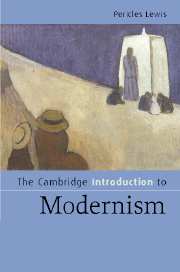Conclusion: after modernism?
Published online by Cambridge University Press: 05 February 2015
Summary
The 1920s were the high point of literary modernism. In general, the more politically oriented writing of the 1930s was markedly less experimental. While Auden, Orwell, and other writers of the 1930s turned to relatively straightforward literary forms, however, James Joyce's work seemed to reach the outer limits of modernist experimentation with language and form. Throughout the 1930s Joyce published excerpts of what would eventually be Finnegans Wake (1939), which combined the anarchic energies of the avant-garde with the epic ambitions of high modernism. The Wake tells of a mythical world, bearing some resemblance to the Dublin of Ulysses (1922), but dreamed of by a sleeping, drunken man, possibly a giant, possibly the dead man at a wake. The novel, referred to during the 1930s as Work in Progress, is written in a language of multilingual puns and is best read by a group of inquisitive people, each one of whom may be able to understand some fragment of this often incomprehensible magnum opus. Joyce complained that critics (including his former mentor Ezra Pound) found the new work “obscure”: “They compare it of course with Ulysses. But the action of Ulysses was chiefly in the daytime, and the action of my new work takes place chiefly at night. It's natural things should not be so clear at night, isn't it now?” It later came to be seen as the first postmodernist text.
- Type
- Chapter
- Information
- The Cambridge Introduction to Modernism , pp. 237 - 248Publisher: Cambridge University PressPrint publication year: 2007



